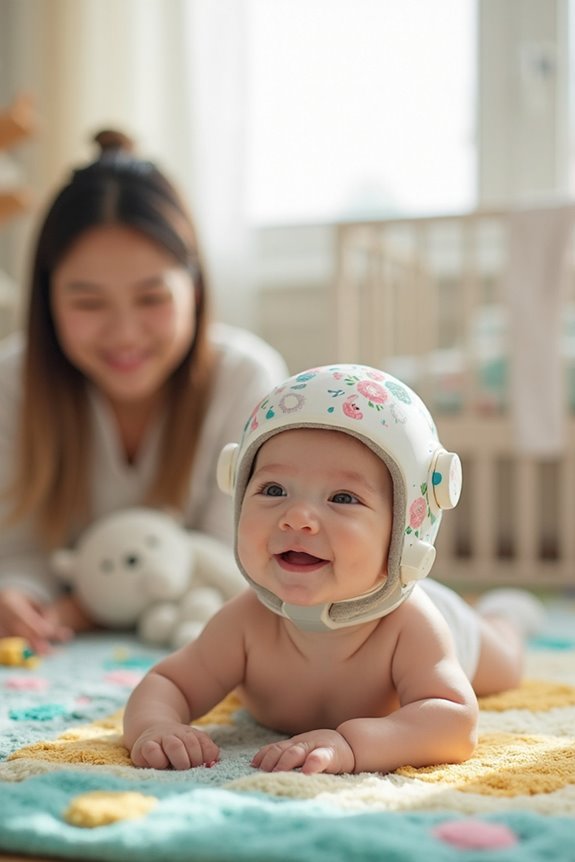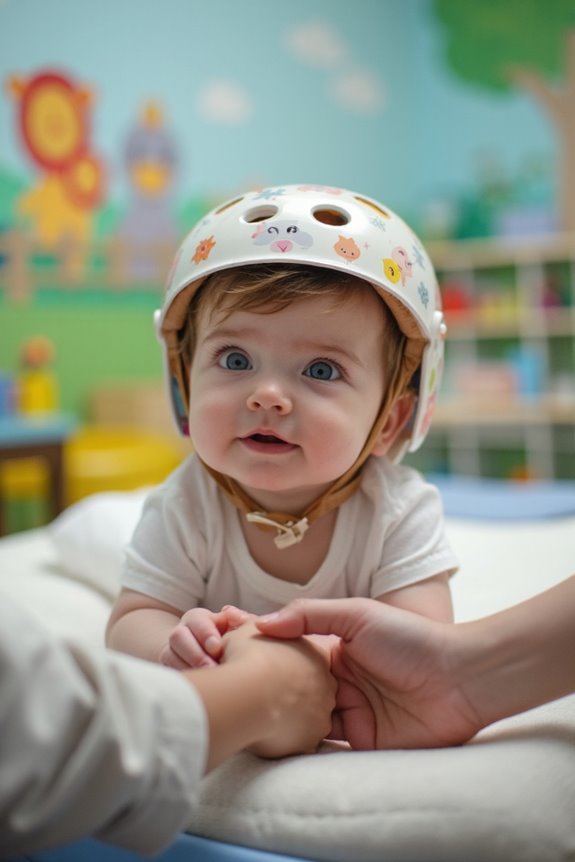Medical helmets for flat head syndrome help reshape a baby’s skull as their soft skulls are prone to flattening. When your baby lies in the same position for long periods, the pressure can create a flat spot. Helmets are designed to cushion and gently guide the skull into a more rounded shape. They’re most effective when worn over 15 hours daily, especially for babies under 9 months. If you’re curious about other treatment options, there’s more to explore.
Key Takeaways
- Medical helmets help prevent further flattening of the skull in infants with flat head syndrome.
- They support normal neurological development during treatment, ensuring healthy growth.
- Helmets are most effective when used for over 15 hours daily, especially before 9 months of age.
- Research shows significant improvements in head shape when therapy starts early.
- Using helmets can address aesthetic concerns for parents, despite no impact on brain development.
Understanding Flat Head Syndrome
When we think about our babies’ health, understanding flat head syndrome is essential, especially since this condition is quite common among infants. Flat head syndrome, or positional plagiocephaly, often stems from pressure on one side of the skull, affecting skull development during those precious early months.
- It can appear as a flat spot on the back or side of the head.
- While it usually doesn’t impact brain growth, it can lead to aesthetic concerns.
Infants’ skulls are malleable, allowing for reshaping, which makes addressing this condition early crucial.
We can help our little ones by practicing tummy time, alternating their sleep positions, and stimulating head movement. Through these simple actions, we can support healthy infant growth and promote a more rounded head shape.
Causes of Flat Head Syndrome

Understanding the causes of flat head syndrome is crucial for us as parents and caregivers, because recognizing these factors can help us take proactive steps to prevent it.
Several key causes include:
- Positional Factors: Babies often spend extended time lying on their backs, which can lead to flat spots.
- Weak Neck Muscles: Many infants have difficulty turning their heads, contributing to uneven pressure on their skulls.
- Soft Skull: A baby’s skull is malleable, making it more susceptible to deformation.
- In-Utero Pressure: Conditions like multiple births can create extra pressure on the baby’s head.
The Role of Medical Helmets

Medical helmets play a crucial role in addressing flat head syndrome, especially when other interventions fall short. They’re designed to provide key helmet benefits, such as cushioning to prevent further flattening and support for normal neurological development.
To ensure effective treatment, we need to follow therapy guidelines closely:
- Wear Time: Helmets should be worn for over 15 hours daily for the best results.
- Age Matters: Starting therapy before 9 months can lead to significantly better outcomes.
- Regular Monitoring: Frequent check-ups with healthcare professionals are essential to track progress and make necessary adjustments.
How Helmets Reshape the Skull

As we explore how helmets reshape the skull, it’s important to recognize the fundamental principles behind their design and function. These helmets utilize specific helmet mechanics to guide cranial growth, promoting a more symmetrical shape. Here’s how they work:
- Customized Fit: Each helmet is tailored to your baby’s head, ensuring it fits snugly.
- Redirect Growth: The design allows for growth in underdeveloped areas while limiting expansion in others.
- Comfort and Materials: Made from thermoplastic sponge and resin sheets, they’re comfortable for your little one.
The Treatment Process Explained

When it comes to helmet therapy, many parents may feel uncertain about what the treatment process entails. We want to reassure you that the journey is straightforward and supportive. Typically, the treatment duration lasts several months, depending on the severity of your baby’s condition.
Here’s what to expect:
- Frequent Visits: Regular check-ups are crucial for helmet adjustments and monitoring progress.
- Gentle Pressure: The helmet applies external pressure, guiding natural head growth to reshape the skull.
- Growth Tracking: As your baby grows, adjustments will be made to ensure a proper fit.
Alternatives to Helmet Therapy

While many parents might feel uncertain about helmet therapy, it’s important to know there are effective alternatives available. We can explore options like the Baby Begin Method, which emphasizes repositioning therapy and tummy time to promote healthy skull formation. Here are some strategies we might consider:
- Repositioning Therapy: Working with pediatric physiotherapists can help us adjust our baby’s sleeping positions.
- Tummy Time: This simple practice helps relieve pressure on the back of the head.
- Pediatric Guidance: Consulting our pediatrician ensures we’re making informed decisions.
- Cost Comparison: Alternatives are often more affordable, typically covered by insurance.
Preventive Measures for Flat Head Syndrome

Understanding the importance of alternative methods to helmet therapy can help us take proactive steps in preventing Flat Head Syndrome. Here are some effective preventive measures:
- Daily tummy time: Let’s start this as soon as our little ones come home. Aim for at least 30 minutes while they’re awake. This strengthens neck muscles and helps prevent flat spots.
- Head repositioning during sleep: By changing your baby’s head position nightly, we can reduce consistent pressure on one spot.
- Encourage interactive play: Engaging our babies in activities that promote movement can improve their head shape and overall muscle tone.
- Limit confined devices: Let’s avoid using swings or bouncy chairs for long periods, allowing our babies to move freely.
With these strategies, we can support our baby’s healthy development together.
Controversies Surrounding Helmet Use

As we dive into the controversies surrounding helmet use for flat head syndrome, it’s essential to recognize that opinions vary widely among parents, healthcare providers, and researchers.
- Helmet Effectiveness: Some studies question the effectiveness of helmets, suggesting they may not be necessary for all infants.
- Insurance Challenges: Many families face financial burdens, as insurance often denies claims for helmets, even when deemed medically necessary. Costs can soar to $4,000 without coverage, making treatment less accessible.
- Cosmetic vs. Medical: Many parents choose helmets for cosmetic reasons, leading to high dropout rates due to discomfort and adjustment needs.
In the end, it’s vital to weigh these factors carefully, as the best choice for your baby should prioritize their comfort and well-being.
Parental Considerations and Support

When we think about our babies’ health, it’s natural to have concerns, especially with conditions like flat head syndrome. As parents, we can enhance our emotional resilience by seeking parental support from healthcare providers and loved ones. Here are some considerations:
- Early Detection: The sooner we identify flat head syndrome, the better the treatment outcomes.
- Open Communication: Let’s discuss our feelings and questions openly with pediatricians.
- Community Resources: Joining support groups can ease our emotional burden.
- Daily Routines: Integrating helmet therapy seamlessly into our daily life helps maintain balance.
- Home Adjustments: Simple changes at home can alleviate stress during treatment.
Long-Term Outcomes of Helmet Therapy

Helmet therapy offers a promising solution for babies with flat head syndrome, and understanding its long-term outcomes can help us make informed decisions about treatment. Research shows that helmet therapy has long-term effectiveness, often achieving better treatment outcomes than repositioning alone.
- Infants under 7.5 months usually see more significant improvements.
- While untreated cases may improve over time, they often don’t achieve ideal head shape.
Additionally, the emotional impact is significant for parents, as a better head shape can enhance satisfaction and reduce stress related to their child’s appearance. It’s vital to remember that, despite concerns, flat head syndrome doesn’t affect brain development. So, let’s embrace the benefits of helmet therapy for our little ones!
Frequently Asked Questions
At What Age Can a Baby Start Wearing a Helmet?
When it comes to helmet fitting, we typically start around three months. This timing aligns perfectly with baby development, ensuring we support their growth effectively while addressing any concerns about head shape together.
How Long Will My Baby Need to Wear the Helmet?
As the saying goes, “Time flies when you’re having fun.” Our baby’s helmet duration usually lasts 3 to 6 months, aligning with their developmental milestones. Let’s cherish this journey together, ensuring the best for our little one.
Are There Any Side Effects of Wearing a Medical Helmet?
When we consider helmet discomfort, it’s important to note that skin irritation is common. We’ve heard from parents that it can be a challenge, but with proper care, our little ones can adjust.
Can I Remove the Helmet for Bathing or Sleeping?
Absolutely, we can remove the helmet for bathing or sleeping. Prioritizing helmet comfort is essential, and proper helmet care during these times helps ensure our little one stays comfortable and healthy. Let’s make it a routine!
How Can I Clean My Baby’s Medical Helmet Properly?
When we think of our little one’s helmet, it’s like caring for a treasured garden. With gentle cleaning techniques and consistent helmet maintenance, we nurture both comfort and hygiene, ensuring our baby blossoms beautifully every day.





